Leonardo da Vinci - Paintings
Adoration of the Magi
"Adoration of the Magi" is the first of the great Leonardo da Vinci paintings, and it is an overture to all Leonardo's work, with figures anticipating The Last Supper. And the skirmish of horsemen in the background is anticipating the central motive of the Battle of Anghiari. The architectural background, the staircase wall with arcades offers such a fine example of the "florentine perspective", mastered by Brunelleschi, and also is uncovering the other Leonardo, the scientist. The painting is the result of seven months of work in the year 1481.
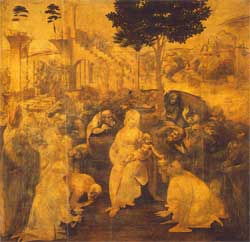
Leonardo da Vinci
Adoration of the Magi
Uffizi, Florence
One might be tempted to affirm that the young Leonardo has made the mistake of other young painters when trying their skills with large compositions, by leaving the most part of the work too dark. Applying his chiaroscuro technique, Leonardo has deliberately painted the chaotic background world using dark tones, separating it from the enlightened figures of Mary and Christ.
The grace and movements of the figures, the expressiveness of heads greatly impressed Raphael more than twenty years later, who, as Vasari says, remained speechless in front of the composition. Later, Raphael will try to imitate that same grace, by borrowing expressions from the Adoration.
The Last Supper
Executed between 1495-1498, The Last Supper is the climax of Leonardo da Vinci's paintings.
Excepting in illuminated MSS., The Last Supper had hardly been seen out of Florence, where frescoes of it by the school of Giotto, and by Orgagna, in Santa Croce and the Ognissanti, must have been known to Leonardo. It was one of the most difficult subjects a painter could undertake: numerous figures, all male, all seated, and all comparatively inactive. But the painters above mentioned, at all events, aimed in the direction of that goal which Leonardo alone reached. The difference between them and him is one of degree, not of kind.
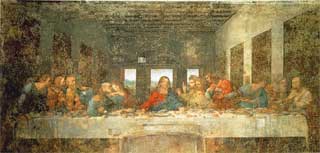
Leonardo da Vinci
Last Supper
Santa Maria delle Grazie, Milan
It is usual to talk of his throwing off the fetters of tradition, but it was certainly not those fetters which obstructed his predecessors, nor the release from them which ensured his success. The traditional feature consisted in little more than the isolated position of Judas on the side of the table nearest the spectator. The more perfect representation of the subject depended solely on the more perfect development of the powers of art, and especially of the art of expression. In this respect Leonardo was pointed out to be the painter of the Last Supper, for he had all the subtleties of expression and action equally within his grasp. Instead of being his difficulty, this was his opportunity.
Twelve different individualities had to be portrayed, all agitated by the same central cause, the words of Christ, and all diversely. Scripture prescribed an impetuous Peter, a gentle and loving John, a guilty son of perdition; but Leonardo cast himself on his own feeling for the rest, and created disciples out of such types of men as best combined to make a grand dramatic whole. He even departed from the letter of Scripture to serve his art, the only authority a true painter acknowledges, and made St. John leaning away from the Lord, instead of on His breast; thus giving greater space and dignity to the chief figure.
The Saviour and His Apostles are seated at, or standing by a long table in a high and stately hall, with their faces or profiles turned towards the spectator. On the extreme left is St. Bartholomew, rising at the end of the table. St. James the Less comes next; then St. Andrew, holding up both hands; St. Peter, with a knife in his hand, Judas, holding the money-bag; and St. John, turning sadly towards St. Peter. Christ is in the centre, and on his right is St. Thomas with uplifted finger; St. James the Greater, his arms outspread; St. Philip, with his hands on his breast St. Matthew, pointing to the central group; and at the end of the table, St. Thaddeus and St. Simon.
Characteristic for Leonardo's paintings, the figures of the apostles are depicted with grand and powerful naturalism, showing the profound agitation aroused by the Saviour's amazing words. The moment chosen for portrayal is that which St. Matthew thus describes: "And as they did eat, he said, Verily I say unto you, that one of you shall betray me; and they were exceeding sorrowful, and began every one of them to say unto him, Lord, is it I?"
The head of Christ caused Leonardo to devote himself to long meditations, wrapped in the contemplation of its ideal divinity; and he used to say that his hand trembled whenever he attempted to paint it. At last, despairing of not being able to attain perfection in this head, he asked counsel of his friend Bernardo Zenale, who said, "O Leonardo, the error into which thou hast fallen is one from which only the Divine Being Himself can deliver thee; for it is not in thy power, nor in that of any one else, to give greater divinity and beauty to any figures than thou hast done to these of James the Greater and the Less. Therefore be of good cheer, and leave the Christ imperfect; for thou wilt never be able to accomplish the Saviour after such apostles."
In the face and attitude of Christ the artist was certainly less successful than elsewhere, and it almost seems that he left these unfinished, in sheer despair, as Lomazzo has carefully recorded. The Abbé Guillon says that in painting the costume he "bore in mind the color and texture of the true garment of Christ, preserved in an Italian church." The face is refined, melancholy, dignified. Some see in it the passionless calm of the Greek gods, and others find there the Byzantine type of Christ, beautified and softened.
This work is equally solitary as combining all the painter's powers. It was thoroughly completed; without over- finish, and without a sign of correction. It bears the aspect of having been executed con amore, a quality hardly characteristic of any other work by the master, whose art has more the air of study than of delight.
All of Leonardo da Vinci's paintings are defined by accurate observation of eye, not innate fervor of spirit. The period, not his own tendencies, caused him, as it did many others, to paint Church pictures; and we have, therefore, to thank the period that such subjects came within the range of his acute perceptions.
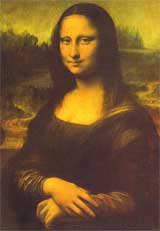
Leonardo da Vinci
Monna Lisa
Louvre, Paris
We have, indeed, to thank the Church for more than is generally acknowledged, that she did supply a demand for at least decorous subjects. Had Art been left to the patronage of profligate patrons, such as were then almost all the princes of Italy, pictures would too often have been identified with subjects unfit for contemplation.
Mona Lisa
Monna Lisa was the subject of Leonardo's most marvelous portrait, the La Joconde, which now adorns the Louvre, and which has been called, by some critics, his supreme masterpiece. She was a beautiful woman, the third wife of Francesco del Giocondo, and, as some suppose, the one most beloved of the artist's soul.
Profounder minds see in this work the crystallization of Leonardo's haunting ideals of supreme beauty, filled with mystery and glamour, and the deepest and most subtle expression. Pater says, "here is the head upon which all the ends of the earth are come, and the eyelids are a little weary. It is a beauty wrought out from within upon the flesh, the deposit, little cell by cell, of strange thoughts and fantastic reveries and exquisite passions."
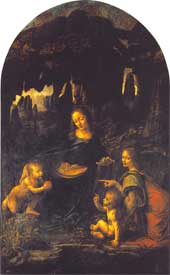
Leonardo da Vinci
Virgin of the Rocks
Louvre, Paris
Perhaps the words of the ancient critic, Félibien, express the matter still better: "It has so much grace, and such sweetness in the eyes and features, that it appears almost living; and it seems to one who sees this portrait, that it is that of a woman that while looking at it one thinks it rather divine than human." Rio, the historian of Christian art, regarded the Monna Lisa as "one of the rarest chef-d'oeuvre that ever issued from the pencil of an artist."
The Virgin of the Rocks
The Virgin of the Rocks (in French La Vierge aux Rochers) is one of the most exquisite of the Italian Madonnas. There are three representations of this scene, of which those in the Louvre and National Gallery in London are the best known.
Some critics are asserting that the one in Louvre belongs to Leonardo's Florentine period, being brought to Milan as a specimen of his skills, thus being executed before 1482. According to this opinion, the painting in the National Gallery is actually that commissioned by the Confraternity of the Immaculate conception in 1483.
Théophile Gautier has wonderfully described the composition: "The aspect of the Virgin is mysterious and charming. A grotto of basaltic rocks shelters the divine group, who are sitting on the margin of a clear spring, in the transparent depths of which we see the pebbles of its bed. Through the arcade of the grotto, we discover a rocky landscape, with a few scattered trees, and crossed by a stream, on the banks of which rises a village. Her head is spherical in form; the forehead well developed; the fine oval of her cheeks is gracefully rounded, so as to enclose a chin most delicately curved; the eyes with lowered lids enclosed with shadow; and the nose, not on a line with the forehead, like that of a Greek statue, but still finely cut."
In 1510, for the Church of San Celso, the master painted his celebrated composition of The Virgin, The Child, and Saint Anne, now in the Louvre.
The miracles attributed to the image of the Virgin at San Celso attracted such a vast wealth of offerings to that church that its clergy commissioned Bramante, Raphael, and Leonardo to execute works of adornment. Leonardo's picture was so famous that Bishop Giovio thought it enough to insure his fame forever, and many repetitions were made by Salai, Luini, and others, for the Italian churches.
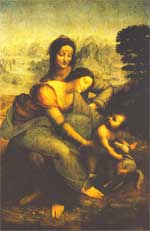
Leonardo da Vinci
The Virgin, The Child,
and St. Anne
Louvre, Paris
In a light-toned rocky landscape the Virgin is seen seated on St. Anna's knees, and the Infant Saviour is playing with a lamb. As Gautier says: "The head of the Virgin is exquisitely fine in outline; her face beams with virginal grace and maternal love; her eyes are bathed in tenderness, and her half-smiling mouth has that indefinable expression of which Leonardo alone knew the secret."
Looking at Leonardo da Vinci's paintings, we can identify what are known to be his favorite excellences: the close modeling, and delicate gradations of light and shade by which he aimed at the utmost roundness and relief. In his "Trattato della Pittura", throughout the numerous paragraphs on the treatment of lights and shadows will be found warnings against "Ombre terminate" or shadows with distinct terminations; urging the student to that observation of the lesser shades and lesser lights by which the extremes of both can be united without line or edge "a uso di fumo," in the manner of smoke, a precept which gave rise to a word of his invention, still in the painter's vocabulary, and without which it would be difficult to define Leonardo's mode of execution, known as "sfumato".